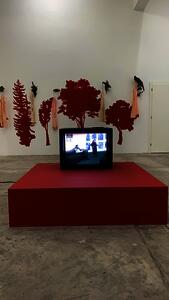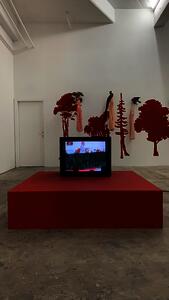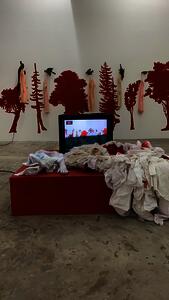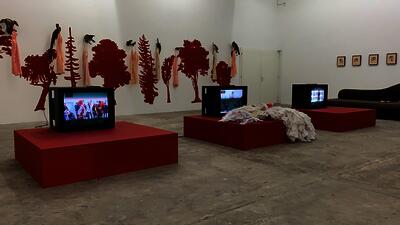KIVLAND, Sharon (2019). Jamais fille chaste n'a lu de romans. [Show/Exhibition] [Show/Exhibition]
Documents
26539:550698
Image (JPEG)
IMG_5148.JPG - Supplemental Material
Available under License All rights reserved.
IMG_5148.JPG - Supplemental Material
Available under License All rights reserved.
Download (179kB) | Preview
26539:550699
Image (JPEG)
IMG_5146.JPG - Supplemental Material
Available under License All rights reserved.
IMG_5146.JPG - Supplemental Material
Available under License All rights reserved.
Download (188kB) | Preview
26539:550700
Image (JPEG)
IMG_5133.JPG - Supplemental Material
Available under License All rights reserved.
IMG_5133.JPG - Supplemental Material
Available under License All rights reserved.
Download (213kB) | Preview
26539:550704
Image (JPEG)
IMG_5132.JPG - Supplemental Material
Available under License All rights reserved.
IMG_5132.JPG - Supplemental Material
Available under License All rights reserved.
Download (229kB) | Preview
26539:550714
Image (JPEG)
IMG_5134.JPG - Supplemental Material
Available under License All rights reserved.
IMG_5134.JPG - Supplemental Material
Available under License All rights reserved.
Download (226kB) | Preview
26539:550715
Image (JPEG)
IMG_5135.JPG - Supplemental Material
Available under License All rights reserved.
IMG_5135.JPG - Supplemental Material
Available under License All rights reserved.
Download (198kB) | Preview
26539:550716
Image (JPEG)
IMG_5147.JPG - Supplemental Material
Available under License All rights reserved.
IMG_5147.JPG - Supplemental Material
Available under License All rights reserved.
Download (215kB) | Preview
26539:550717
Image (JPEG)
IMG_5145.JPG - Supplemental Material
Available under License All rights reserved.
IMG_5145.JPG - Supplemental Material
Available under License All rights reserved.
Download (196kB) | Preview
26539:550718
Image (JPEG)
PHOTO-2019-11-12-10-00-26.jpg - Supplemental Material
Available under License All rights reserved.
PHOTO-2019-11-12-10-00-26.jpg - Supplemental Material
Available under License All rights reserved.
Download (155kB) | Preview
26539:550719
Image (JPEG)
PHOTO-2019-11-12-10-00-12.jpg - Supplemental Material
Available under License All rights reserved.
PHOTO-2019-11-12-10-00-12.jpg - Supplemental Material
Available under License All rights reserved.
Download (143kB) | Preview
26539:550721
Image (JPEG)
IMG_5141.JPG - Supplemental Material
Available under License All rights reserved.
IMG_5141.JPG - Supplemental Material
Available under License All rights reserved.
Download (214kB) | Preview
26539:550734
Image (JPEG)
IMG_5139.JPG - Supplemental Material
Available under License All rights reserved.
IMG_5139.JPG - Supplemental Material
Available under License All rights reserved.
Download (203kB) | Preview
26539:550749
Image (JPEG)
IMG_5137.JPG - Supplemental Material
Available under License All rights reserved.
IMG_5137.JPG - Supplemental Material
Available under License All rights reserved.
Download (213kB) | Preview
26539:550761
Image (JPEG)
PHOTO-2019-11-12-10-00-20.jpg - Supplemental Material
Available under License All rights reserved.
PHOTO-2019-11-12-10-00-20.jpg - Supplemental Material
Available under License All rights reserved.
Download (206kB) | Preview
26539:550766
Image (JPEG)
PHOTO-2019-11-12-10-00-00.jpg - Supplemental Material
Available under License All rights reserved.
PHOTO-2019-11-12-10-00-00.jpg - Supplemental Material
Available under License All rights reserved.
Download (199kB) | Preview
26539:550773
Image (JPEG)
IMG_5143.JPG - Supplemental Material
Available under License All rights reserved.
IMG_5143.JPG - Supplemental Material
Available under License All rights reserved.
Download (399kB) | Preview
Abstract
The work/s are structured on the education of women and women as readers. Jean-Jacques Rousseau sets the scene (‘a chaste girl has never read a novel’), with the display of volumes I and II of his epistolary novel Julie, or La nouvelle Helöise, originally published under the title Lettres de Deux Amans, Habitans d’une petite Ville au pied des Alpes (‘Letters from two lovers, living in a small town at the foot of the Alps’). The book was a wild sensation. Many readers would not accept it was fiction. The title of the exhibition is taken from a remark in his introduction.
There is a suggestion of the impropriety of reading throughout. There is reference to Sylvain Maréchal’s tract ‘Plan for a law forbidding a woman to learn to read’ (1801), which consists of eighty-two clauses, fortified by a hundred and thirteen reasons, to prove that the woman who knows the alphabet has already lost a portion of her innocence (his friend and biographer Madame Gacon Dufour declared that he must be partially insane), in acquiring excessive education, linking innocence and ignorance, carnal knowledge and book knowledge (we can find this too, in Sigmund Freud’s analysis of the young hysteric ‘Dora’). The tract was republished in 1853 as Il ne faut pas que les femmes sachent lire (‘Women must not learn how to read’). The eighteenth-century doctor Samuel-Auguste Tissot proposed that any daughter exposed to novels at a tender age will come down with hysteria later. He is often cited, though the source of the quotation cannot be established, becoming rather a medical axiom that knots women, hysteria, and reading.
After Rousseau’s sensational novel and Maréchal’s insane tract, Gustave Flaubert’s Madame Bovary and Karl Marx’s Capital are the secondary texts of the exhibition: a seeming opposition between literature and political philosophy, yet one that is a logical pairing in the spectre of social boundaries failing to hold, when what is private and what is public are no longer separate spheres. The first takes up the staging of the affliction of the woman reader, for Emma Bovary reads too much and her reading is bound to lead to trouble (‘her over-exalted dreams, her too cramped house [les rêves trop hauts … la maison trop étroite’ ]. In reading Capital, women readers are equally dangerous. Reading women have subversive potential, and reading leads to errancy and transgression.
The first space is a school-room, containing eight desks, on which are school cahiers from the Vaud, with beige-pink covers on which there is a drawing of a doe. Eight absent writers, women friends of the artist, have laboriously copied out all references to the commodity – la marchandise – from the first three chapters of Capital, in sanguine ink. Each desk, which seats two good pupils, has two chairs: one empty, the other occupied by a diligent squirrel, holding in its dear little paws culottes in varying shades of pink, made from a light fabric with a satin weave called charmeuse, the face lustrous and reflective while the back has a dull finish. It is also a person (a woman) who knows how to please. On these, red phrases worked in soie de Paris replace more familiar monograms (which would denote possession). Instead the phrases signify the lovely object that is the commodity, showing the mutable forms taken by mademoiselle la marchandise. On one wall a group of poster-like photographs show young girls at different periods (from the 1930s to 1960s) drawing or painting in the classroom, the first traces of the hand, one might say. On one wall the shapes formed by the childish brush in the classroom are enlarged and reproduced in dark red paint, floating abstract forms. On another wall is a row of eight blousons d’écolier, like those worn by the children in the photographs, the smock or overall uniform that is no longer worn. They hang from the upturned feet of taxidermied deer. Some blousons are black, with a neat red trim, and all hold a copy of Capital stuffed tightly into a pocket, or fallen to the floor, too heavy, too large to be hidden or contained. The two volumes of Julie are presented on a lectern, as are two volumes of Madame Bovary, Emma separated from Julie by a century of reading.
In the second space one moves into to something like a boudoir; at least, it has a divan for reclining and a lovely scene of a Swiss landscape in red. On one wall, there is row of eight books on a lectern, paperback copies of Madame Bovary, each cover giving a certain impression of ‘Emma’, according to the time it was published. On another wall, eight drawings depict women with bobbed hair in negligés and bed-jackets, reading and dreaming, their cheeks a little flushed, reclining in bed. Their bed-jackets are liseuses in French, and a liseuse is also a little lamp for reading, or a tiny knife (sometimes with a little hook with which to mark a page), or the jacket of a book itself. If their outfits, those light garments for women described in a masculine term, are feminised: négligées, they become those who demonstrate lack of care or do not take sufficient pains or wear a garment that barely covers them. Their books have red covers. Goodness, we certainly know what kind of books have red covers; they are not novels, pernicious enough, but equally dangerous. Is it a solitary pleasure? Are their hands lightly below the sheets? Are they educating themselves? Do they dream of political action, of new kinds of subjectivity? The girl children will grow up, as one may see in the many photographs on another wall, taken from French lingerie magazines, showing corps morcélés.
Slips (combinaisons), in silk, satin, lace, and that new material Nylon, which requires no ironing, embroidered with interdictions on the education of women (Maréchal, of course, and others), echo the culottes of the first room, suspended in beaks and claws of birds (a buzzard, a kingfisher, a grive, a pair of doves…). They are part of the artificial Swiss landscape, the red forest that reflects the trees painted by children in the schoolroom.
Women once learnt to read through embroidering, as art or craft or labour, women’s work in any case, where the skill of the needlework was more important that the mastery of cursive script. There was a time that only the catechism and needlework were taught, but some demanded more, to be taught about everything. They read, and they learnt quickly. They understood forms. They assumed forms.
There was an opening event, which extended the concept of the exhibition, during which three artists, Fabienne Audeoud, Christina Joensson, and Linda Stupart, performed on their own red ‘stage’ or podium, situated in the centre of the supposed ‘boudoir’. The residue and recording of their performance remained for the period of the exhibition.
More Information
Statistics
Downloads
Downloads per month over past year
Share
Actions (login required)
 |
View Item |


 Tools
Tools Tools
Tools![[thumbnail of PHOTO-2019-11-12-10-00-26.jpg]](https://shura.shu.ac.uk/26539/21.hassmallThumbnailVersion/PHOTO-2019-11-12-10-00-26.jpg)

![[thumbnail of PHOTO-2019-11-12-10-00-12.jpg]](https://shura.shu.ac.uk/26539/22.hassmallThumbnailVersion/PHOTO-2019-11-12-10-00-12.jpg)

![[thumbnail of PHOTO-2019-11-12-10-00-20.jpg]](https://shura.shu.ac.uk/26539/64.hassmallThumbnailVersion/PHOTO-2019-11-12-10-00-20.jpg)

![[thumbnail of PHOTO-2019-11-12-10-00-00.jpg]](https://shura.shu.ac.uk/26539/69.hassmallThumbnailVersion/PHOTO-2019-11-12-10-00-00.jpg)

